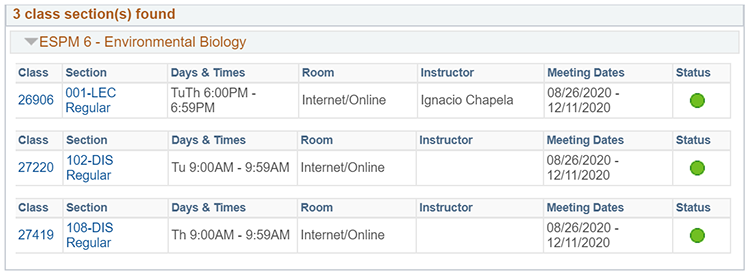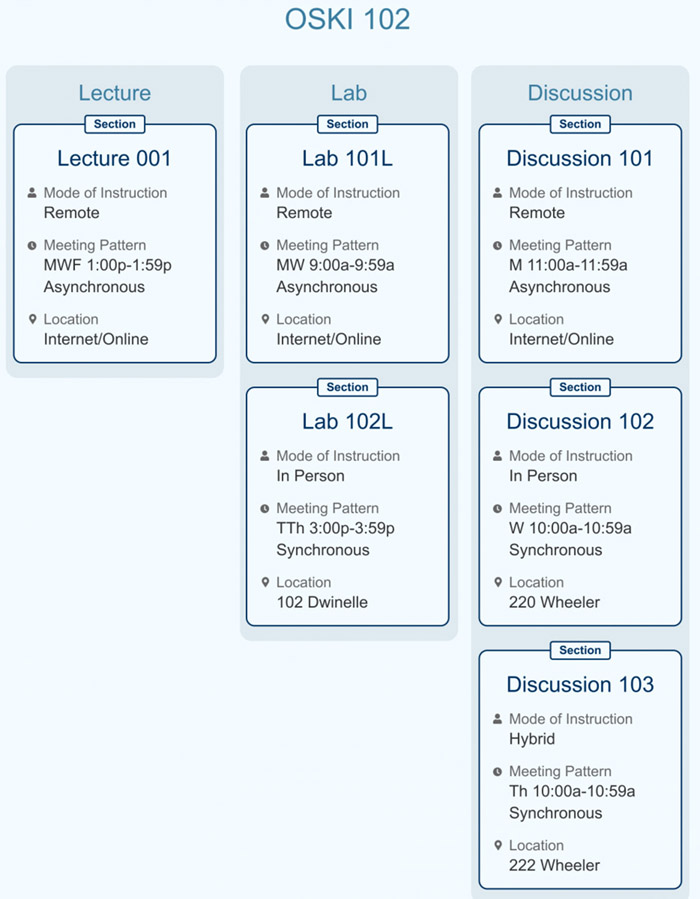Overview
“Mode of Instruction” is how a class component—lecture, discussion, lab, etc.—is delivered in a given semester. Modes of instruction may include in-person, remote, web-based, or online. In previous semesters flexible and hybrid were also used. The definitions of modes of instruction are given below. You can search by these categories using the “modes of instruction” search filter in the class search. Most class components — lecture, discussion, lab, etc.—will be in-person, while others will be remote, online, or web-based.
Students can find classes using the “mode of instruction” filter in the Berkeley Academic Guide Class Schedule or the CalCentral Schedule of Classes. Mode of instruction is noted on the class details page of each section and may vary within a course. The lecture and the discussion section or lab may have different modes of instruction. For example: The lecture, the lab, and 2 of the possible discussion sections may be remote, while 2 other possible discussion sections are available in-person.
Defining Modes of Instruction and Other Terminology
Course: A class, with a unique course number (e.g., AEROSPC 1A), which may include one or more instructional components (lecture, discussion, lab, etc.). To accommodate students and instructors during the pandemic, some courses were changed to include remotely delivered components. In choosing to enroll in a course, it is very important to look at all of the components of the course. Some components may be in-person, others may be remote. Some remote offerings may be synchronous; others may be asynchronous. Please read below for definitions of different modes of instruction.
Class component: A component of a course has its own meeting pattern and section number (e.g., Math 1A Discussion Section 111 or Math 1A Lecture 001). Depending on the course, class components may take the form of lectures, seminars, discussions, labs, etc. In general, primary class components (e.g., lecture, fieldwork) appear as 001, 002, etc., and secondary class components (e.g., discussion, lab) appear as 101, 202, etc. In the example below, 001 is the lecture component of the class, while 102 and 108 are the discussion sections. Despite common usage on campus, in the CalCentral enrollment system the word “section” is not the same as “discussion section” but also includes lectures, labs, seminars, etc. Below is an example of how a student selects specific components of a class (referred to as class sections) when registering for a course.

Example of a search result from CalCentral for ESPM 6 – Environmental Biology.
In-person (Mode of Instruction): A class component that meets completely or primarily in-person. Physical attendance on campus is expected.
- In-person class components will be assigned a campus location and meeting pattern.
- In-person classes may or may not have course capture available.
- Look for additional information and details specific to the class component under “class notes” on the class details page.
Remote (Mode of Instruction): A class component that is fully online or remotely delivered, with no in-person instruction whatsoever. Delivery may be synchronous or asynchronous.
- Remote class components will be assigned a location of Internet/Online.
- Synchronous remote sections will be assigned a meeting pattern in the class schedule. Details for asynchronous participation, if available, will be listed under “class notes” or in the syllabus.
- Look for additional information and details specific to the class component under “class notes” on the class details page.
Web-Based and Online (Mode of Instruction): A web-based course has been designed from the ground up to be delivered online, and many of these courses were developed pre-COVID. Such courses undergo an approval process through the Academic Senate to be delivered online.
Multiple Mode Courses: A multiple-mode course is one that allows students the choice to participate either in-person or remotely, depending on the class components in which they enroll. Each component of the class (e.g., lecture, labs, or discussion sections) is assigned its own mode of instruction. Students should check to make sure they are registering for class components appropriately. After the add/drop deadlines, student schedule changes require the dean’s approval. Note that the remote offerings may be synchronous or asynchronous; please be sure to check the class notes section, as described below. For an example, see the courses OSKI 101 and OSKI 102 described below.
- Information about the mode of instruction of each class component can be found under “class notes” on the class details page.
- In-person, flexible, and hybrid components of multiple-mode courses will each be assigned a physical location and meeting pattern. Synchronous remote class components will be assigned a meeting pattern. Asynchronous remote class components will have a location of Internet/Online.
Synchronous: A synchronous class component is one in which students are expected to participate in the class component during the days and times that are specified on the schedule of classes. Participation may be in-person or remote, depending on the mode of instruction. A meeting pattern is specified on the schedule of classes, for example, AEROSPC 1A Lec 001 is scheduled for Mondays from 2:00–2:59 p.m.
Asynchronous: An asynchronous class is one in which the instructor pre-records a presentation and makes it available to students to watch later at a time of their choosing. Asynchronous engagement may also include collaborative annotations, discussion threads, etc. Some classes with the “asynchronous” notation may be asynchronous only; others may have a synchronous option—consult the class notes or class syllabus for details. In either case, students are held to assignment completion deadlines and are responsible for consulting with the instructor to determine the final exam schedule, ensuring no time conflicts with other examinations. A meeting pattern will display in the class schedule to ensure faculty and students can easily identify which exam group a section is assigned, as well as determine if there are exam conflicts.
- To find asynchronous sections, filter for them on the Academic Guide’s Class Schedule and the CalCentral Schedule of Classes. In CalCentral, the asynchronous attribute appears under the “online courses” class attribute dropdown menu.
Time Conflict Enrollment: “Time conflict enrollment allowed” means that a student may enroll in the course even if the time conflicts with another enrolled course. If time conflict enrollment is allowed, it will be tagged as such in the class schedule. However, it is the student’s responsibility to ensure that there is not a final exam time conflict. If there is, the student must choose between the two classes. No final exams will be rescheduled due to time conflicts. Some classes with the “asynchronous” notation may be asynchronous only; others may have a synchronous option—consult the class notes or class syllabus for details. An asynchronous class may allow for time conflicts, or it may not. A time conflict enrollment allowed course may be asynchronous or it may not.
Example of a Course with Multiple Modes of Instruction
Example 1: OSKI 101
- A course of 250 students that consists of 1 lecture section, 1 lab section, and 12 discussion sections may offer the following options for enrollment:
- Lecture = 1 Remote section (asynchronous only)
- Lab = 1 Remote section (synchronous but recorded so students can participate later)
- Discussion = 3 remote sections (asynchronous only), 2 remote sections (synchronous with no recording), 3 in-person sections (synchronous), and 4 hybrid sections (synchronous)
Example 2: OSKI 102
- A course of 75 that consists of 1 lecture section, 2 lab sections, and 3 discussion sections: while the lecture is remote and asynchronous for all students, the lab can be either remote or in-person, and the discussion can be remote, in-person, or hybrid (see graphic below).
An example “Oski 102” class that displays section information in three columns labelled “Lecture,” “Lab,” and “Discussion.” Each section lists Mode of Instruction, Meeting Pattern, and Location.

Example of class components from CalCentral Schedule of Classes.
A course may offer many options (via mode of instruction) for participation. Students must review the mode of instruction for each section in which they enroll, not just the day and time, to ensure they can fully participate and complete the course.